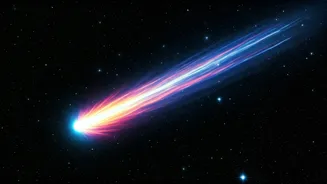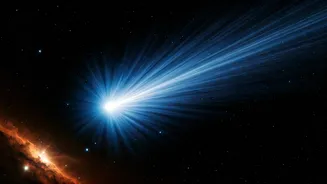What Is 3I/ATLAS?
The 3I/ATLAS comet, designated as such due to its discovery by the Asteroid Terrestrial-impact Last Alert System (ATLAS) in 2019, represents a fascinating
object in our solar system. Unlike many comets that originate from the Oort cloud or Kuiper belt, 3I/ATLAS has an interstellar origin, meaning it traveled into our solar system from a different star system. Its journey highlights the dynamic nature of space and the infrequent occurrences of interstellar objects. Scientists are keenly interested in studying its composition and trajectory, as this offers the possibility of gaining more understanding of the formation of other planetary systems. The study of interstellar comets is relatively new, and the knowledge gained from these objects can provide insights into the diversity and distribution of materials present in the galaxy beyond our solar system. The unusual path of 3I/ATLAS made its observation a priority for astronomers worldwide, as it could provide valuable new data about objects from other star systems.
The Elon Musk Warning
Elon Musk's statements regarding the 3I/ATLAS comet have generated considerable interest. His comments, emphasizing the comet is 'not an ordinary comet', signaled potential for something extraordinary to take place. Though his precise concerns weren't fully detailed in public statements, the sentiment reflects a common attitude among astronomers and space experts to approach all interstellar objects cautiously, considering the unknown. His warning, coupled with the silence from NASA, has only served to increase speculation and curiosity about the comet's potential hazards or the implications of its approach. The specific reasons behind Musk's warning remain open to interpretation; it has definitely caught the public's attention and fueled interest in the 3I/ATLAS comet.
When and Where to Watch
Tracking and observing the 3I/ATLAS comet requires a combination of precise timing and optimal conditions. While specific dates vary, astronomers work to predict the best viewing times. Given its interstellar nature and path, the comet's visibility depends on where it is in relation to Earth and the sun. Clear, dark skies away from light pollution are essential for viewing. Telescopes and high-powered binoculars are likely to be needed to observe it. Experts would encourage stargazers to consult reliable astronomy sources, such as sky charts and online resources, for the most accurate and up-to-date information on the comet's precise position and expected visibility period. These resources offer essential guidance to find the comet in the night sky. Public events such as organized stargazing sessions are a possibility as astronomers worldwide watch the 3I/ATLAS comet.
Scientific Significance
The scientific value of the 3I/ATLAS comet rests on its interstellar origin. Unlike comets within our solar system, its makeup provides clues to the environments beyond our neighborhood. The materials the comet has may not be available within our solar system, giving us valuable insights into the origin and evolution of different star systems. The study of this comet gives astronomers opportunities to test existing models of planetary formation and the distribution of elements in the cosmos. Analysing its trajectory, speed, and composition, astronomers can learn more about the interstellar medium and the nature of objects that travel through it. Furthermore, the 3I/ATLAS comet's presence serves as a reminder of the connections between different star systems and the shared history of the universe. The comet therefore holds significant value as a window into the nature of the wider universe.
NASA's Stance
NASA's approach to the 3I/ATLAS comet has been a subject of interest, particularly in comparison to Elon Musk's strong statements. It's important to understand the typical protocol for any celestial object that approaches the Solar System. NASA, like other space agencies, has a regular process for observing and assessing potential risks posed by near-Earth objects. The absence of an open warning about 3I/ATLAS from NASA doesn’t mean the agency ignored the comet; rather, it suggests that its assessment did not find any immediate threat. Instead, NASA continues to gather data and coordinate with international partners in astronomy to learn more about the comet, to learn more about its behavior and trajectory. In the field of space exploration, the focus has always been on combining scientific curiosity with prudent planning, which means that the public can expect information, based on current understanding.












